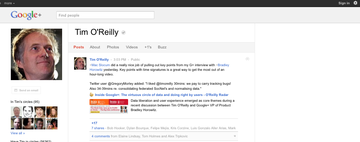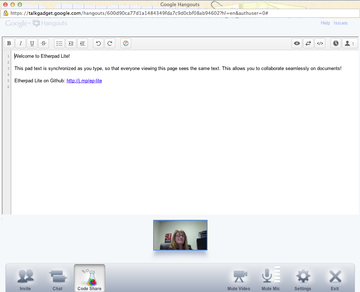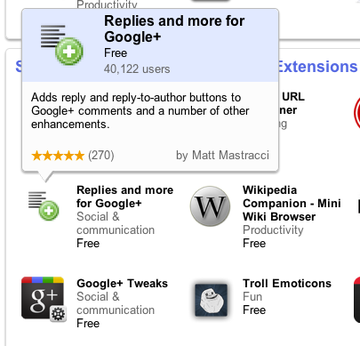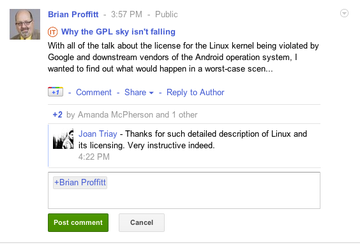« Previous 1 2
Google+ Means Business
Sharing from Google+
John Blossom, President of Shore Communications Inc., says that he uses Google+ to build an audience for his content and to build relationships with potential and existing clients. “Google+ builds on Buzz by providing a much easier way to share information with specific people in private with its Circles feature, but also enables easy public sharing of content and comments, both on Google+ itself and on the web,” Blossom says (Figure 7). “In this way, Google+ is notably different than Facebook, LinkedIn, and many other social media services, which typically require one to be logged in to see any content on their services, limiting or curtailing its ability to be discovered via search engines.”
Hangouts Are Huge
“Google+ also makes it possible to initiate group video and text chats with up to ten people, a feature that has been used extensively by Google to collect feedback from people using Google+, but is used increasingly for small-scale webinars and other more business-oriented services,” Blossom says.
Although Google+ Hangouts only allowed up to 10 participants at launch, users quickly found ways around this limitation by recording their video sessions and sharing them publicly. For example, some teachers are recording hangouts to use as webinars. Currently Google+ doesn’t have a built-in way to record hangouts, but free third-party tools are available.
On July 15, the Tibet Action Institute held a Hangout press conference, which they claim is the first global press conference on Google+. The conference was recorded with Ustream and is now available at the tibetnetwork.org site.
Businesses are already leveraging Google+ Hangouts for meetings and training. For example, you and several colleagues located from remote offices could use Google+ to meet online. Unlike IRC or Skype meetings, attendees have the advantage of seeing each other, watching video together, or viewing other training materials.
For example, a Hangout meeting attendee could show other attendees how to assemble a new company product or introduce a new office employee to the offsite staff. Or, a salesperson could meet in a Hangout with new clients to discuss product options, and an engineer could meet with customers who need tech support or training.
Enterprising Add-Ons
Although Google is currently mum on upcoming plans for Google+, users have already been busy extending the product’s functionality.
The Chrome extension Hangout Pad for Google+ already has more than 1,300 users. Google+ users who install this extension can click on the icon on the bottom of the Hangout screen (Figure 8) to open a shared window for collaborative coding (Figure 9).
 Figure 8: YouTube videos aren’t the only thing you can share in Hangouts. A Chrome add-on allows for collaborative coding.
Figure 8: YouTube videos aren’t the only thing you can share in Hangouts. A Chrome add-on allows for collaborative coding.
In his webcast with Tim O’Reilly, Bradley Horowitz admitted that he uses the Replies add-on, which currently has more than 40,000 users, indicating that this feature is in demand even though it is not built in (Figures 10 and 11).
Beyond Beta
Beta testers are sending detailed feedback to Google about what’s missing or could be improved in Google+. According to John Blossom, “As of now, Google+ lacks features that can help people to separate business networking from personal networking with a high level of efficiency, and lacks the ‘go-to’ status for business use that a service like LinkedIn enjoys.” He says, “It would be very difficult using the current features of Google+ to launch a B2B marketing campaign, for example.”
Blossom says that despite controversy surrounding Google+ requirements for users to use “real” names instead of pseudonyms, he commends them for their intentions. “They are doing this in part to ensure that searches that reference content in Google+ are evaluating content from people who are not trying to game search algorithms with multiple false IDs or to hide behind a false ID to promote interests such as commercial products or politicians.”
Blossom says Google+ also needs more features to enable content discovery. “As of now, there is no search feature built in to Google+, although it is possible to find publicly posted content in Google+ via the main Google search feature,” he says. “Also, Google+ does not yet support any sort of content categorization or tagging schemes, though some early users of Google+ have adopted Twitter’s convention of hashtags (the # character followed by a keyword) as an informal method of identifying content relating to particular keyword topic; however, without search features built around such metadata, they are not very useful so far.”
Dan Keldsen, President of Information Architected Inc. uses Google+ to work in real time with distributed teams. “It’s not quite replacing Skype for video conferencing, or ‘pure’ Google Docs for live co-editing of agendas, proposals, and meeting notes, but it’s showing more immediate promise than Google Wave,” he says. “It is still difficult to work with larger companies while using Google+ due to the requirement of a Gmail account,” Keldsen adds.
Keldsen thinks that Google’s new social media product seems like a smarter Twitter because extended conversations are easier to follow. He says it’s a smarter blogging platform because of real time and a more “web native” ability to drop in multimedia, and because its not walled, like Facebook, it’s better for business collaboration. Keldsen says that Google seems much more serious about the Google+ launch than they were with Google Wave. “Still early days for Google+, but this is one of the least ‘beta’ offerings that Google has launched that I can recall,” he says.
Rikki Kite is Director of Marketing at Advanced Clustering Technologies in Kansas City, Kansas. In addition to Linux Magazine and Linux Pro Magazine, Kite has been published in Sys Admin Magazine and on UnixReview.com. She can be contacted at rkite@advancedclustering.com.
« Previous 1 2
Subscribe to our ADMIN Newsletters
Subscribe to our Linux Newsletters
Find Linux and Open Source Jobs
Most Popular
Support Our Work
ADMIN content is made possible with support from readers like you. Please consider contributing when you've found an article to be beneficial.










